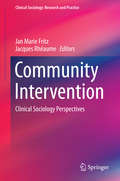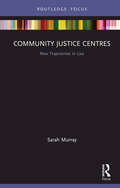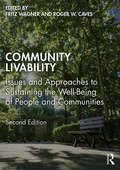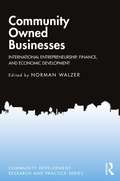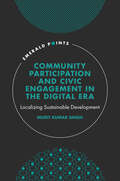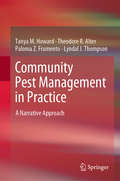- Table View
- List View
Community Intervention: Clinical Sociology Perspectives (Clinical Sociology: Research and Practice)
by Jan Marie Fritz Jacques RhéaumeCommunity Intervention: Clinical Sociology Perspectives showcases important efforts to improve the quality of life in communities around the world. The book, a project of the clinical sociology division of the International Sociological Association, describes the interdisciplinary field of clinical sociology in relation to community improvement. The first part of the book covers important concepts and tools for community intervention and identifies a variety of approaches to community research with an emphasis on research that centrally involves community members. The chapters in the second part of the volume focus on projects in a broad range of countries, covering topics such as involving residents in urban renewal projects, developing healthy communities, encouraging socioeconomic development, improving the life of immigrants, helping communities deal with climate change, establishing human rights cities, encouraging empowerment and creating an inclusive community. A unique feature of the book is the inclusion of profiles about some of the outstanding work in community intervention over the last 100 years. These profiles are of Nobel Peace Prize winner Jane Addams; community activist Saul Alinsky; human rights and environmental activist Wangari Maathai and participatory action research pioneer Orlando Fals Borda. Written by scholar-practitioners as well as analysts, the book provides essential commentary regarding community intervention efforts.
Community Interventions and AIDS
by Edison J. Trickett Willo PequegnatAs news headlines report staggering numbers of people infected with HIV or AIDS across the globe and as stereotypes of typical AIDS patients become less and less specific to particular sexual orientations and ethnic backgrounds, the AIDS pandemic shows little sign of relenting. AIDS crosses geopolitical and social barriers, and social and behavioral scientists are confronted with the new challenge of developing scientific inquiry and corresponding interventions around participatory, community-based, and community-focused methods. These interventions are increasingly targeting the contextual influences on individual behavior, such as peer groups, social networks and support systems, and community norms. Community-level interventions also draw on local resources and are respectful of sociocultural circumstances and traditions. This book articulates how the social and behavioral sciences can respond to HIV/AIDS. It is written for all who have a stake in AIDS research, stimulating discussion and debate about the natures of community research and intervention broadly across such disciplines as public health, community health education, urban planning, psychology, sociology, anthropology, and philosophy of science. The book proposes alternative perspectives on means of ascertaining knowledge about the HIV/AIDS pandemic and the inclusion of community collaboration in interventions.
Community Justice Centres: New Trajectories in Law (New Trajectories in Law)
by Sarah MurrayThis book examines the phenomenon of Community Justice Centres and their potential to transform the justice landscape by tackling the underlying causes of crime. Marred by recidivism, addiction, family violence, overflowing courtrooms, crippling prison spending and extreme rates of incarceration, the criminal justice system is in crisis. Community Justice Centres seek to combat this by tackling the underlying causes of crime in a particular neighbourhood and working with local people to redesign the experience of justice and enhance the notion of community. A Community Justice Centre houses a court which works with an interdisciplinary team to address the causes of criminality such as drug addiction, cognitive impairment, mental illness, poverty, abuse and intergenerational trauma. The community thus becomes a key agent of change, partnering with the Centre to tackle local issues and improve safety and community cohesion. This book, based on research into this innovative justice model, examines case studies from around the world, the challenges presented by the model and the potential for bringing its learnings into the mainstream. This book will appeal to academics in law and criminology as well as psychology; it will also be of considerable interest to people working in the criminal justice system, including the police, government policy advisers, psychologists and social workers.
Community Justice Centres: New Trajectories in Law (New Trajectories in Law)
by Sarah MurrayThis book examines the phenomenon of Community Justice Centres and their potential to transform the justice landscape by tackling the underlying causes of crime. Marred by recidivism, addiction, family violence, overflowing courtrooms, crippling prison spending and extreme rates of incarceration, the criminal justice system is in crisis. Community Justice Centres seek to combat this by tackling the underlying causes of crime in a particular neighbourhood and working with local people to redesign the experience of justice and enhance the notion of community. A Community Justice Centre houses a court which works with an interdisciplinary team to address the causes of criminality such as drug addiction, cognitive impairment, mental illness, poverty, abuse and intergenerational trauma. The community thus becomes a key agent of change, partnering with the Centre to tackle local issues and improve safety and community cohesion. This book, based on research into this innovative justice model, examines case studies from around the world, the challenges presented by the model and the potential for bringing its learnings into the mainstream. This book will appeal to academics in law and criminology as well as psychology; it will also be of considerable interest to people working in the criminal justice system, including the police, government policy advisers, psychologists and social workers.
Community Life
by Graham Crow Graham AllanFirst published in 1994. Routledge is an imprint of Taylor & Francis, an informa company.
Community Life
by Graham Crow Graham AllanFirst published in 1994. Routledge is an imprint of Taylor & Francis, an informa company.
Community Life for the Mentally Ill: An Alternative to Institutional Care
by George W. Fairweather David H. Sanders David L. Cressler Hugo Maynard"Community Life for the Mentally Ill" presents a social innovative experiment aimed at providing new and more participating social positions in American society for mental patients. It presents the events that occurred when a courageous group of former chronic mental patients abruptly left a hospital and established their own autonomous sub-society in a large, metropolitan area.In order to complete this experiment, the patients created a small society in the community where discharged patients could live and work. Others evaluated the effects of the newly created society upon the behavior and perceptions of its members, which is also presented here. Both the descriptive and comparative aspects of this study are presented as they occurred in real life. The book is concerned with the medical, economic, sociological, and psychological facets of these former patients' daily lives. The effects of this small society upon the neighborhood and city in which it was located, as well as its effects upon professional persons, are richly explored.Clearly defining a radical departure from standard methods for treating the mentally ill, the authors conclude that such an autonomous society can thrive in the appropriate setting; the ex-patient's chances of employment are increased and the chance of recidivism are reduced; the member's self-esteem is enhanced; treatment costs are greatly reduced; the community adjustment of all members is increased, especially among those who have been hospitalized for a long period. With new guidelines for identifying danger zones in urban settings, this becomes a critical work.
Community Life for the Mentally Ill: An Alternative to Institutional Care
by George W. Fairweather David H. Sanders David L. Cressler Hugo Maynard"Community Life for the Mentally Ill" presents a social innovative experiment aimed at providing new and more participating social positions in American society for mental patients. It presents the events that occurred when a courageous group of former chronic mental patients abruptly left a hospital and established their own autonomous sub-society in a large, metropolitan area.In order to complete this experiment, the patients created a small society in the community where discharged patients could live and work. Others evaluated the effects of the newly created society upon the behavior and perceptions of its members, which is also presented here. Both the descriptive and comparative aspects of this study are presented as they occurred in real life. The book is concerned with the medical, economic, sociological, and psychological facets of these former patients' daily lives. The effects of this small society upon the neighborhood and city in which it was located, as well as its effects upon professional persons, are richly explored.Clearly defining a radical departure from standard methods for treating the mentally ill, the authors conclude that such an autonomous society can thrive in the appropriate setting; the ex-patient's chances of employment are increased and the chance of recidivism are reduced; the member's self-esteem is enhanced; treatment costs are greatly reduced; the community adjustment of all members is increased, especially among those who have been hospitalized for a long period. With new guidelines for identifying danger zones in urban settings, this becomes a critical work.
Community Literacies as Shared Resources for Transformation (Expanding Literacies in Education)
by Joanne Larson George H. MosesThrough multiple narratives reflecting the complexity of participatory action research partnerships for social justice, this book sheds light on the dialogic spaces that intentionally support community literacies and rhetorical practices for inquiry and change. Applying literacy as social practice, Larson and Moses tell a story of a unique collaboration between community members and university faculty and students, who together transformed an urban corner store into a cornerstone of the community. Building on the emerging field of community literacies, the book captures the group’s active work on the ground and, on another level, how transformation occurred in the dialogic spaces of the research team as it learned to embrace distributed expertise and multiple identities.
Community Literacies as Shared Resources for Transformation (Expanding Literacies in Education)
by Joanne Larson George H. MosesThrough multiple narratives reflecting the complexity of participatory action research partnerships for social justice, this book sheds light on the dialogic spaces that intentionally support community literacies and rhetorical practices for inquiry and change. Applying literacy as social practice, Larson and Moses tell a story of a unique collaboration between community members and university faculty and students, who together transformed an urban corner store into a cornerstone of the community. Building on the emerging field of community literacies, the book captures the group’s active work on the ground and, on another level, how transformation occurred in the dialogic spaces of the research team as it learned to embrace distributed expertise and multiple identities.
Community Livability: Issues and Approaches to Sustaining the Well-Being of People and Communities
by Fritz Wagner Roger CavesWhat is a livable community? How do you design and develop one? What does government at all levels need to do to support and nuture the cause of livable communities? Using a blend of theory and practice, experts in the field look at evidence from international, state and local perspectives to explore what is meant by the term "livable communities". Chapters examine the various influencing factors such as the effect and importance of transportation options/alternatives to the elderly, the significance of walkability as a factor in developing a livable and healthy community, the importance of good open space providing for human activity and health, restorative benefits, the importance of coordinated land use and transportation planning, and the relationship between livability and quality of life. While much of the discussion of this topic is usually theoretical and abstract, Wagner and Caves use case studies from North America, Brazil and the United Kingdom to provide substantive examples of initiatives implemented across the world. This book fills an important gap in the literature on livable communities and at the same time assists policy officials, professionals and academics in their quest to develop livable communities.
Community Livability: Issues and Approaches to Sustaining the Well-Being of People and Communities
by Fritz Wagner Roger CavesWhat is a livable community? How do you design and develop one? What does government at all levels need to do to support and nuture the cause of livable communities? Using a blend of theory and practice, experts in the field look at evidence from international, state and local perspectives to explore what is meant by the term "livable communities". Chapters examine the various influencing factors such as the effect and importance of transportation options/alternatives to the elderly, the significance of walkability as a factor in developing a livable and healthy community, the importance of good open space providing for human activity and health, restorative benefits, the importance of coordinated land use and transportation planning, and the relationship between livability and quality of life. While much of the discussion of this topic is usually theoretical and abstract, Wagner and Caves use case studies from North America, Brazil and the United Kingdom to provide substantive examples of initiatives implemented across the world. This book fills an important gap in the literature on livable communities and at the same time assists policy officials, professionals and academics in their quest to develop livable communities.
Community Livability: Issues and Approaches to Sustaining the Well-Being of People and Communities
by Fritz Wagner Roger W. CavesWhat is a livable community? How do you design and develop one? What does government at all levels need to do to support and nurture the cause of livable communities? Using a blend of theory and practice, the second edition of Community Livability addresses evidence from international, state and local perspectives to explore what is meant by the term "livable communities." The second edition contains new chapters from leading academics and practitioners that examine the various factors that constitute a livable community (e.g., the influence and importance of transportation options/alternatives to the elderly, the importance of walkability as a factor in developing a livable and healthy community, the importance of good open space providing for human activity and health, restorative benefits, etc., the importance of coordinated land use and transportation planning), and the relationship between livability and quality of life. A number of chapters focus on livable communities with case studies from an international perspective in USA, Canada, Australia, Peru, Sweden, South Korea, Japan, and Austria.
Community Livability: Issues and Approaches to Sustaining the Well-Being of People and Communities
by Fritz Wagner Roger W. CavesWhat is a livable community? How do you design and develop one? What does government at all levels need to do to support and nurture the cause of livable communities? Using a blend of theory and practice, the second edition of Community Livability addresses evidence from international, state and local perspectives to explore what is meant by the term "livable communities." The second edition contains new chapters from leading academics and practitioners that examine the various factors that constitute a livable community (e.g., the influence and importance of transportation options/alternatives to the elderly, the importance of walkability as a factor in developing a livable and healthy community, the importance of good open space providing for human activity and health, restorative benefits, etc., the importance of coordinated land use and transportation planning), and the relationship between livability and quality of life. A number of chapters focus on livable communities with case studies from an international perspective in USA, Canada, Australia, Peru, Sweden, South Korea, Japan, and Austria.
Community Mental Health and Behavioral-Ecology: A Handbook of Theory, Research, and Practice
by A. M. Jeger R. S. SlotnickThis volume is addressed to professionals and students in community mental health-including researchers, clinicians, administrators, educa tors, and students in relevant specialities within the fields of psychology, psychiatry, social work, public health, and nursing. The intent of this book is to serve as a practical resource for professionals and also as a di dactic text for students. In addition,·the volume seeks to make a theoret ical contribution to the field by presenting, for the first time in book form, a behavioral-ecological perspective in community mental health. We present behavioral-ecology as an emerging perspective that is concerned with the interdependence of people, behavior, and their sociophysical environments. Behavioral-ecology attributes mental health problems to transactions between persons and their settings, rather than to causes rooted exclusively within individuals or environments. In this vol ume we advance the notion of behavioral-ecology as an integration of two broad perspectives--behauioral approaches as derived from the indi vidual psychology of learning, and ecological approaches as encompassing the study of communities, environments, and social systems. Through the programs brought together in this book we are arguing for a merging of these two areas for purposes of advancing theory, research, and prac tice in community mental health.
Community Nutrition Resilience in Greater Miami: Feeding Communities in the Face of Climate Change (Palgrave Studies in Climate Resilient Societies)
by Franziska Alesso-BendischThis book conceptualizes community nutrition resilience as a critical area that is currently lacking the attention it requires from both the public and private sectors. The book spotlights Greater Miami’s resilience efforts, both responding to slowly developing challenges such as immigration, environmental deterioration, and the wealth distribution gap, as well as sudden disasters such as hurricanes or flooding driven by climate change. Drawing on existing literature as well as interviews with professionals working in the field, the author makes recommendations on how to incorporate food systems into urban resilience planning, how to prioritize resilience on urban food agendas, and how to strengthen food system resilience through public, private, and third sector level engagement. She also highlights how the availability of and access to nutritious food impact the health, performance, and well-being of communities in the region, thus making a strong case for the prioritization of this growing issue.
Community Operational Research: OR and Systems Thinking for Community Development (Contemporary Systems Thinking)
by Gerald Midgley Alejandro Ochoa-Arias"This is the book I have been waiting for. Community Operational Research has shown that analysis can be used not only for, but also with, community groups, helping them to gain more control of their situations. What Midgley and Ochoa-Arias' volume does is provide not only rich examples of grass-roots practice, but also thought-provoking theoretical explorations. The editors have a point of view, but they allow space for debate with those who interpret Community OR differently." Jonathan Rosenhead (Emeritus Professor of Operational Research, London School of Economics and Political Science; Ex-President of the ORS)
Community Organizations: Studies In Resource Mobilization And Exchange
by Carl MilofskyLocal nonprofit organizations are often small, loosely structured, and democratically governed, and therefore do not fit conveniently into traditional theories of organizational behavior that are rooted in administrative science and bureaucratic structure. Treating community organizations as parts of larger systems--organizational fields or ecologies and communities--this collection of papers presents various perspectives on local nonprofit organizations from the standpoint of organizational theory. The essays draw on an array of methods and theoretical approaches taken from population ecology theories of organizations, laying the foundation for the structural analysis of community organizations.
Community Organizations: Studies in Resource Mobilization and Exchange (Yale Studies on Non-Profit Organizations)
by Carl MilofskyLocal nonprofit organizations are often small, loosely structured, and democratically governed, and therefore do not fit conveniently into traditional theories of organizational behavior that are rooted in administrative science and bureaucratic structure. Treating community organizations as parts of larger systems--organizational fields or ecologies and communities--this collection of papers presents various perspectives on local nonprofit organizations from the standpoint of organizational theory. The essays draw on an array of methods and theoretical approaches taken from population ecology theories of organizations, laying the foundation for the structural analysis of community organizations.
Community Organizing (Social Movements)
by David S. WallsThis incisive book provides a critical history and analysis of community organizing, the tradition of bringing groups together to build power and forge grassroots leadership for social, economic, racial, and environmental justice. Begun by Saul Alinsky in the 1930s, there are today nearly 200 institution-based groups active in 40 U.S. states, and the movement is spreading internationally. David Walls charts how community organizing has transcended the neighborhood to seek power and influence at the metropolitan, state, and national levels, together with such allies as unions and human rights advocates. Some organizing networks have embraced these goals while others have been more cautious, and the growing profile of community organizing has even charged political debate. Importantly, Walls engages social movements literature to bring insights to our understanding of community organizing networks, their methods, allies and opponents, and to show how community organizing offers concepts and tools that are indispensable to a democratic strategy of social change. Community Organizing will be essential reading for advanced undergraduates and graduate students of sociology, social movements and social work. It will also inform organizers and grassroots leaders, as well as the elected officials and others who contend with them.
Community Owned Businesses: International Entrepreneurship, Finance, and Economic Development (Community Development Research and Practice Series)
by Norman WalzerThis book analyses community-owned businesses in countries around the world to show successful approaches and important strategies to improve access to essential services in vastly different economic contexts. Through eleven chapters, authors from various countries use case studies and analyse findings in ways which can be applied to new development initiatives, including rural grocery store retention in Kansas, socially responsible community cooperatives in Italy, preserving pubs and shops in England and Wales, serving residents with special needs in Canada, and financing basic goods and services for aging populations in Taiwan, plus other examples. The chapters explore practices and approaches used in various locations to address concerns about loss of access to essential services, making clear that this approach to financing is useful in different scenarios. The chapters provide key insights suggesting that these approaches will be even more prevalent in the future and will be of interest to students, scholars, and community-development practitioners around the world.
Community Owned Businesses: International Entrepreneurship, Finance, and Economic Development (Community Development Research and Practice Series)
by Norman WalzerThis book analyses community-owned businesses in countries around the world to show successful approaches and important strategies to improve access to essential services in vastly different economic contexts. Through eleven chapters, authors from various countries use case studies and analyse findings in ways which can be applied to new development initiatives, including rural grocery store retention in Kansas, socially responsible community cooperatives in Italy, preserving pubs and shops in England and Wales, serving residents with special needs in Canada, and financing basic goods and services for aging populations in Taiwan, plus other examples. The chapters explore practices and approaches used in various locations to address concerns about loss of access to essential services, making clear that this approach to financing is useful in different scenarios. The chapters provide key insights suggesting that these approaches will be even more prevalent in the future and will be of interest to students, scholars, and community-development practitioners around the world.
Community Participation and Civic Engagement in the Digital Era: Localizing Sustainable Development (Emerald Points)
by Mudit Kumar SinghUnderstanding the challenges in research and practice of participation in the digital era, and the important role of local governance in achieving the sustainable development goals, Community Participation and Civic Engagement in the Digital Era unfolds the complex relationship of community participation, social capital and social networks. Singh presents an in-depth literature review alongside case studies from developing countries, showcasing the role of participation in sustainable development, and explaining how digital development creates technological tools and a virtual space for community engagement – increasing the complexity of community participation and civic engagement, and the potential for implementing the sustainable development goals at a local level. From the historic concept and forms of participation to describing and analysing the environmental and individual factors shaping practice of participation, community development interventions and local governance, the book culminates in a discussion of future work and challenges in the digital world. Delivering a careful review of the theoretical and practical problems of community participation in the digital age and featuring applied theories and cases which appeal to public policy makers and researchers, Community Participation and Civic Engagement in the Digital Era offers a rich theoretical perspective and detailed critical review of social capital and social networks that has profound application in the fields of political science, sociology and development economics.
Community Participation and Civic Engagement in the Digital Era: Localizing Sustainable Development (Emerald Points)
by Mudit Kumar SinghUnderstanding the challenges in research and practice of participation in the digital era, and the important role of local governance in achieving the sustainable development goals, Community Participation and Civic Engagement in the Digital Era unfolds the complex relationship of community participation, social capital and social networks. Singh presents an in-depth literature review alongside case studies from developing countries, showcasing the role of participation in sustainable development, and explaining how digital development creates technological tools and a virtual space for community engagement – increasing the complexity of community participation and civic engagement, and the potential for implementing the sustainable development goals at a local level. From the historic concept and forms of participation to describing and analysing the environmental and individual factors shaping practice of participation, community development interventions and local governance, the book culminates in a discussion of future work and challenges in the digital world. Delivering a careful review of the theoretical and practical problems of community participation in the digital age and featuring applied theories and cases which appeal to public policy makers and researchers, Community Participation and Civic Engagement in the Digital Era offers a rich theoretical perspective and detailed critical review of social capital and social networks that has profound application in the fields of political science, sociology and development economics.
Community Pest Management in Practice: A Narrative Approach
by Tanya M. Howard Theodore R. Alter Paloma Z. Frumento Lyndal J. ThompsonThis book presents a collection of practitioner and community stories that reveal how invasive species management is a community issue that can spark community formation and collective action. It combines the unique first-person narratives of practitioners on the frontline of invasive species management in Australia with three case studies of community action for wild dog management across a range of geographical landscapes. The book offers readers a new understanding of how communities are formed in the context of managing different species, and how fundamental social and political processes can make or break landholders’ ability to manage invasive species. Using narrative analysis of practitioner profiles and community groups, drawing lessons from real-world practices, and employing theories from community development, rural sociology and collective action, this book serves multiple functions: it offers a teaching tool, a valuable research contribution, and a practitioner’s field guide to pursuing effective community development work in connection with natural resource management, wildlife management and environmental governance.
